France’s most loved rocker
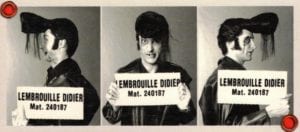
Part 1
We must start our trip with Antoine de Caunes (1953-), a Parisian from a wealthy family, son of television journalist-reporter Georges de Caunes and television announcer Jacqueline Joubert.
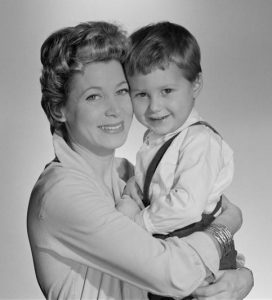
De Caunes was thus an embodiment of what in French is called bon-chic bon-genre (roughly ‘classy, good breed’) or BCBG for short, the French equivalent of the yuppies, but that background should not blind us to his many quirks and qualities. He has had a lifelong interest in pop music, or more precisely in Anglo-Saxon ‘rock’ music rather than in the ballads of the ‘chanson francaise’.
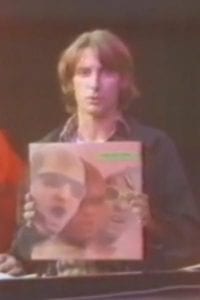
Presented ‘Chorus’ (1978-81) Théatre de l’Empire, Paris, presenting from the rooftop of that theatre shows which include Crazy Cavan in jeudi1980.
<iframe width=’100%’ height=’100%’ frameborder=’0′ marginheight =’0′ marginwidth=’0′ scrolling =’no’ src=’https://player.ina.fr/player/embed/I10281372/1/1b0bd203fbcd702f9bc9b10ac3d0fc21/wide/1′></iframe>
In the series ‘Les Enfants du Rock’ (1982-88).
‘Rapido’ (1988-92) & ‘Eurotrash’ (1993-2004)
‘Bop’n’Roll Party’ (1982)
Antenne 2 réalise en 1982 le Bop n’ Roll PARTY un fabuleux live de Rockabilly as a special for the Thursday evening ‘les Enfants du Rock’ (‘Rock’s Children’, a series that ran between 1982 and 1988). L’émission de TV présenté par Antoine De Caunes met en scène des pionniers du genre et des groupes de Revival et se trouve immortalisés par un double album Big beat records (BBR 1004/1005) le tout se déroule au Studio Davoux le 25 et 26 Janvier 1982.
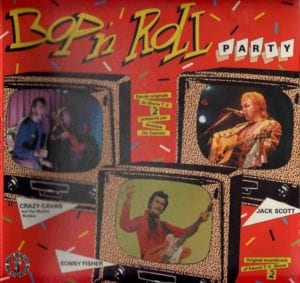
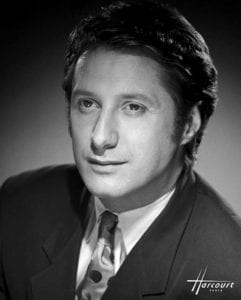
Sa passion pour le rock l’amène à produire et à présenter l’émission Houba-Houba pour Les Enfants du Rock.
Antoine de Caunes y lance Rock Report, sorte de journal télévisé du rock, construit uniquement sur des sujets et reportages, précurseur de l’émission Rapido qu’il va lancer brièvement sur TF1 à l’automne 1987 avant de la déménager sur Canal+
De 1984 à 1991, Antoine de Caunes anime une émission de radio nommée Marlboro Music, enregistrée dans les studios de Jean-Michel Steward Productions à Paris, avec des reportages enregistrés aux USA. Il se déplace ainsi toutes les semaines de ville en ville, faisant découvrir le son des différentes villes des États-Unis. L’émission est diffusée sur un réseau de 150 stations FM dont Skyrock et Europe 2. Il y eut en tout 334 émissions.
Les textes de Marlboro Music sont écrits par Antoine De Caunes et Laurent Chalumeau, un de ses grands amis depuis leur rencontre dans l’émission Chorus.
De 1985 à 1990, rédacteur de l’émission de radio Marlboro Music, animée par Antoine de Caunes et diffusée par Skyrock, Europe 2 et 150 radios locales.
A son retour en France en 1990, il se joint à l’équipe de Canal+ et, pendant cinq ans, fournit chaque jour le texte du personnage qu’interprète Antoine de Caunes à la fin de Nulle Part Ailleurs. Il participe ensuite aux débuts de l’aventure Canal+, ce qui lui vaut une importante popularité, not least because of his character Didier Lembrouille.
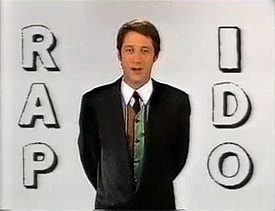
Part 2
Didier Lembrouille (mimetically deedyeh lombrooy, whose name translates as ‘Stroppy Didier’ or perhaps more rather ‘Didier the Narker’) was created as a character by Antoine de Caunes and the writer Laurent Chalumeau for the television programme ‘Nulle Part Ailleurs’. ‘Nulle Part Ailleurs’ (‘Nowhere Else’) was a freeview general-interest talk show on the pay-channel Canal Plus designed to tempt viewers to subscribe to the channel which ran on weekdays between 18:30–20:30 for 13 years between 1987–2000 . The name of the programme name was supposed to suggest to viewers that the channel was ground-breaking and offered something not to be found elsewhere on French television and ‘Nulle Part Ailleurs’, indeed, became a roaring success, not least because of the comic slot which aired towards the end of the programme in which Antoine de Caunes would act as a provocative buffoon in a theme designed to accord with the celebrity guest of the day. De Caunes had originally joined the team as the presenter of a humorous commentary slot, but this role was forgotten in 1990 when he decided to engage full-time in his clowning duties as mischief-maker towards the end of the serious interview of the day’s guest by the avuncular anchor Philippe Gildas (De Caunes would subsequently be joined by José Garcia, who was originally the programme’s crowd warmer). De Caunes performed these comic characters continually on a daily basis during the show’s 200 annual broadcasts between 1990 and 1995. The count was lost, but he estimated that he inhabited over 400 characters during these years [Doc 1], a number of which were recurring ones, notably: Ouin Ouin the nerdy French scout; Aquarium the doped-up hippy; Gérard Languedepute; Raoul Bitembois, Gilles Gros-Paquet, Super Gros Con, David Kopperfield, Bomba, Pignolo the clown, Le Fou (‘The Madman’), Maya l’Abeille (cartoon character ‘Maya the Bee’) being some of the recurring ones. However, one character was supremely successful in capturing the public imagination: the stroppy and talkative rocker Didier Lembrouille, whose appearances ran for just under four years in 1991–95.
The usual pattern was that Philippe Gildas, the avuncular and jovial presenter of the programme, would be interviewing the day’s celebrity when they would be rudely interrupted by Didier Lembrouille (or any of the other characters) who would begin a humoristic and pointed monologue around a particularly subject associated with the celebrity.
‘Nulle Part Ailleurs’ was shot live which meant that Chalumeau had to finish each of De Caunes sketches under a tight deadline which he likened to “mini emergencies”. There was preparation during the week, but the dialogue would only be ready about 6 pm on the night, half-an-hour before the show opened, and they would sometimes wait for the evening’s guest to appear before running to a shop to find corresponding clothes and accessories. There was more often than not no time for rehearsing. Pierre Gildas, the show’s host, never knew what to expect as De Caunes (and his accomplice Garcia) would start to put on their disguises at the very last limit, around 8 pm, only half-an-hour before the show’s close. Chalumeau and De Caunes made the most of the live nature of the transmission to inject schoolyard humour, with dirty words or phrases hidden in the characters’ names. Their sketches displayed a brazenness that often verged on a mocking disrespect of the guest. Gildas noticed that De Caunes got carried away playing Didier Lembrouille, and probed as to whether he liked to stick two fingers (the French equivalent is one finger) to the audience and corresponded most closely to him his reply was simply ‘Didier’.
Although it’s only in 1991 that the character Didier Lembrouille made his first appearance, this was preceded around 1990 by one appearance of de Caunes as the son of Dick Rivers when he was the guest of ‘Nulle Part Ailleurs’.

Part 3
On the face of it, Didier Lembrouille, is a stereotypical rock’n’roller from a ‘mythical’ working-class high-rise suburb of Paris named Rancy-sur-Yvette (‘Rancid [sperm] on Yvette’) in the ‘mythical’ departement of Bas-Marne ‘Lower Marne’ (or in Lembrouille’s context ‘Low-class Marne’) which approximates with the real-life suburb of Valenton, caught between major roads and rail-lines and areas of heavy industry, mostly built up since the 1950s.
Before embarking on Didier Lembrouille’s back-story it helps to understand him that he is obsessed with singer Dick Rivers who started his career as the singer of the rock’n’roll group the Chats Sauvages in 1961–62. Dick Rivers is the third best known of a trio of well-known French rock’n’roll singers who emerged in the early 1960s occupying the bronze position after Eddy Mitchell, singer of the Chaussettes Noirs, occupying silver and Johnny Hallyday occupying gold. Despite their American-sounding names all three were Frenchmen, respectively: Johnny being Jean-Philippe Smet (1943-2017, Paris), Eddy being Claude Moine (b.1942, also Paris) and Dick being Hervé Fornieri (b.1945, Nice).

Each has gone on to enjoy successful careers as solo artists with Dick having completed 32 albums, Eddy 50 and Johnny 79, at the latest count. All three have nurtured their reputations as singers of rock’n’roll (or rock as it is generally known) despite having become, like Elvis, basically singers of ballads or contemporary musical styles with only a peppering of unconvincingly performed ‘rock’n’roll’ tunes. Of the three, Dick Rivers is possibly the most genuine in his love for rock’n’roll but he is far from what would count as a proper rock’n’roll singer as he was during his time long ago in the Chats Sauvages, but then the French musical public is more eclectic than on this side of the Channel! Both Eddy and Johnny have become household names in France with only their first names needing to be mentioned – just like with our Cliff – but Dick Rivers seems always to have lagged behind in the popularity stakes. So there we have it, by the 1990s Dick Rivers had the reputation of a rock’n’roll singer who, although once well-known, was ‘past-it’ and over-the-hill who only deserved to be the obsessions of ‘losers’ …
Enter Didier Lembrouille …
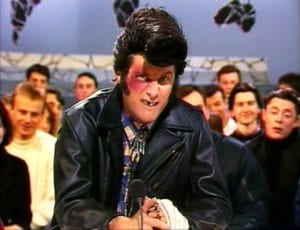
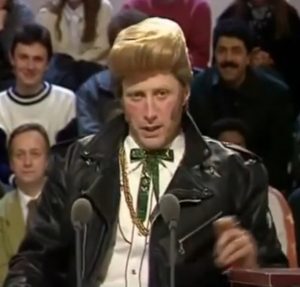
Following the last performance in 1995 after which he left the show, De Caunes and his writing partner Laurent Chalumeau brought out a humorous album entitled Didier Lembrouille: le dossier (‘Didier Lembrouille: the File’) containing transcripts of some of the show’s sketches but which also gave Lembrouille’s back-story, some of it written in the form of puportedly official police reports.
Part 4
The origin of Didier Lembrouille’s character lies in Laurent Chalumeau’s
Les textes de Marlboro Music sont écrits par Antoine De Caunes et Laurent Chalumeau, un de ses grands amis depuis leur rencontre dans l’émission Chorus.
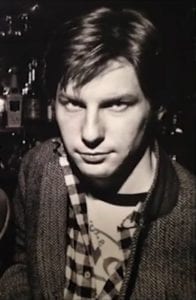

FBcomm 2012 “De Caunes est né ‘fils de’, mais bordel , quel talent . C mes vingts ans et mon premier appart , je ne loupais jamais une de ses prestations , surtout ‘ didier’ . Il a bien vieillit , j adore ce mec.”
Dick Rivers dedicates his song ‘est-ce que tu le sais ?’ to Didier Lembrouille “who unfortunately couldn’t make it tonight” at a concert in Marne-la-Vallée near Paris in April 1996 (wink and you might miss it at 2:06!)
Post Comment